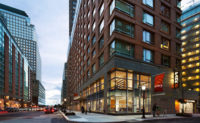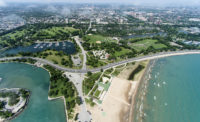G Ateliers Architecture
San Crist'bal, Medell'n, Colombia
Cool and urbane, the Fernando Botero Library Park stands sentry on the hillside of San Cristóbal, a rough-edged “urban village” on Medellín’s western fringes. The city’s sixth library-park, it is one of the newest additions to the public building program here, which has garnered worldwide attention in recent years. “It is a difficult topography,” says G Ateliers Architecture’s Orlando Garcia of the mountainous terrain dotted by informal brick construction, “so we wanted to do a simple yet powerful building.” Referring to the constraints of time, budget, and the local workforce’s ability, Garcia notes, “We worked with the reality of our means. That is also part of understanding the context.”
In 2001 the architect, who is from Medellín, relocated to New York City, where he eventually established a practice. Later, in the face of the recession and with all his projects on hold, he amped up his participation in competitions. When he won the commission for the San Cristóbal library in 2009, he returned to Medellín for the duration of the project.
Like the library-parks that precede it, this one (named for Medellín-born figurative artist Fernando Botero) is a community center for the underserved. But it stands apart as the first designed for one of Medellín’s five corregimientos— agricultural/urban townships on the city’s outskirts. San Cristóbal, which grew in the shadow of the city, has gained a recent visibility thanks to a new highway connecting the Pacific and Caribbean coasts that passes through the district. The competition brief for this new building (which is part of a larger plan that will include a hospital and government administration offices) spelled out the basic programmatic needs: a lending library, daycare, computer rooms, meeting spaces, and visual and performing arts facilities. As the project progressed, members of the community became involved in the preliminary program phase, says Garcia: “Their desires and dreams are reflected in this building.”
To free up as much of the site as possible for open public space while retaining existing footpaths, and to simplify construction, the architects designed a bar-shaped volume with a small footprint. The library stands out dramatically against the background of surrounding buildings with their sides of unfinished brick block that face the valley. “We thought our building could honor its context by also having these openings looking to the landscape,” says Garcia. “The idea of using perforations to intensify the identity of the place, and as a texture for the building, became the driving idea.” To keep things simple and on budget, the team employed humble, sprayed-concrete insulated panels as cladding for the concrete-framed building, and dressed it up by painting it black. While the 48,000-square-foot building asserts its presence during the day, it vanishes in the landscape at night, its windows twinkling along with thousands of others on the hillside.
From a distance the library appears monolithic. But the interior is a series of carved voids that offer surprising glimpses through and between the spaces. On a recent morning, schoolchildren popped out on balconies, while teenagers congregated in the shade of deep overhangs below. Meanwhile, a group of senior citizens chanted the Lord’s Prayer in the open-air vestibule that looks down to the entry atrium, before jogging a lap around the building. The black walls flow inside as plaster on a brick block and CMU substrate. The somber hue underscores the building’s importance as a place of learning but also its role as a backdrop animated by the natural environment and human activity. “One of the ideas,” says Medellín-based associate designer Adriana Salazar, “was for each window to capture a detail of the landscape, which is a complex collage of images—from the rural town to the mountains and highway.” As children study in the reading room, buses zip by below. Across the building in the music school another window reveals two women lost in conversation in a pasture, cows grazing beyond.
Ennobling a simple material palette rendered a building that appears serious but not severe. Everything is cheap and locally sourced, including brick from a nearby factory, oak paneling, and black terrazzo floor tiles. In an unusual move, the team made a 300-square-foot, full-scale mockup on-site to test materials and methods, hoping to avoid delays during construction, which took just 13 months.
The Fernando Botero Library Park has quickly become an important resource for San Cristóbal. And it achieves this without condescending to a marginalized population. Instead, it communicates a dignity and respect for knowledge and community and for those who come seeking these things. “The people here have appropriated the library and its services and have become very protective of it,” says acting library coordinator María Marcela Ocampo Rodríguez. Garcia takes the observation one step further: “The building is going to embed itself in the collective memory of the village,” he predicts. “We hope that soon it will be hard to imagine San Cristóbal without it.”
ARCHITECT: G Ateliers Architecture (Orlando Garcia, design principal; Adriana Salazar, project team).
BUDGET: $103/square foot (construction cost).
CONTEXT: A township on the west side of the Aburrá Valley on the fringes of Medellín. It comprises 17 hamlets and is dependent on flower cultivation and agriculture.
People |
Products |





























Post a comment to this article
Report Abusive Comment